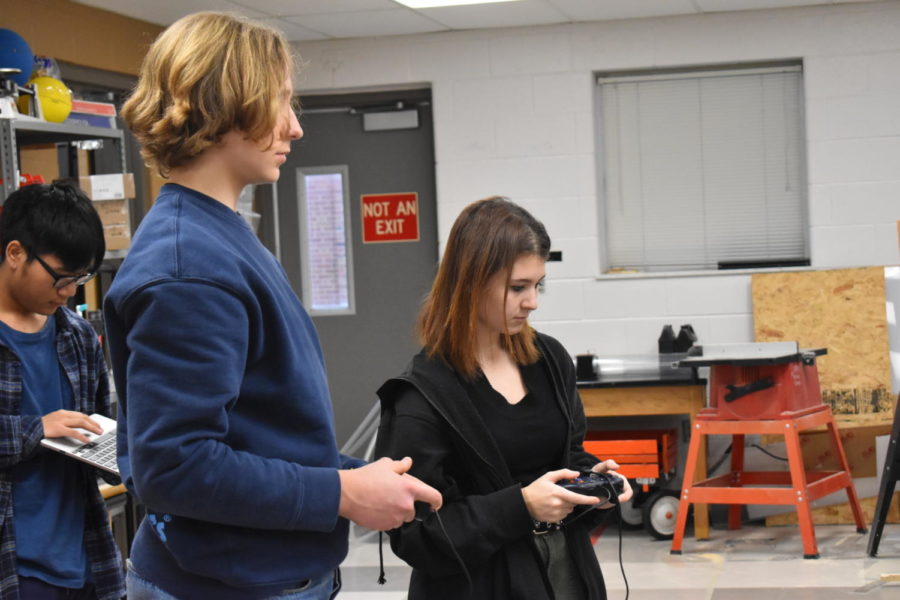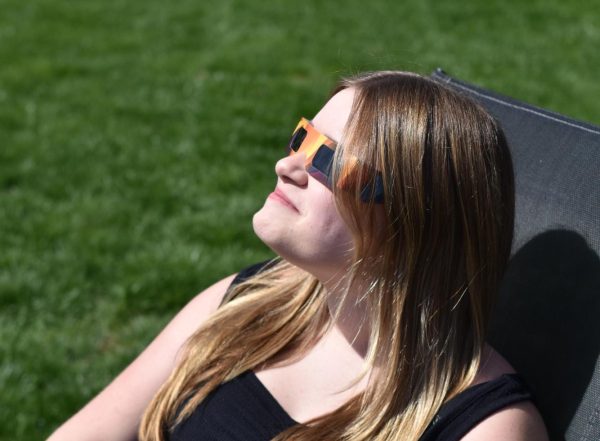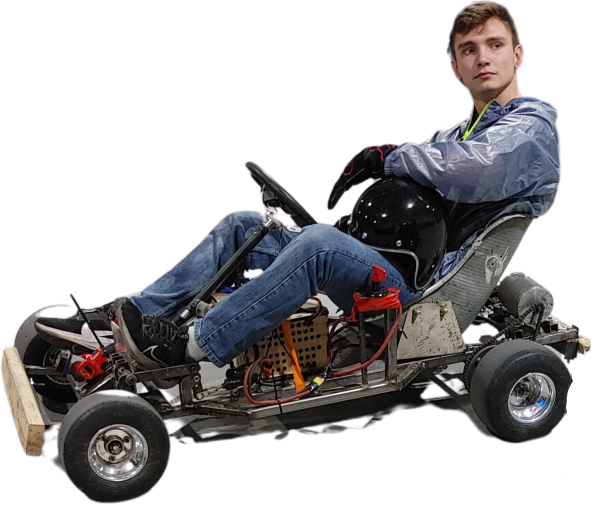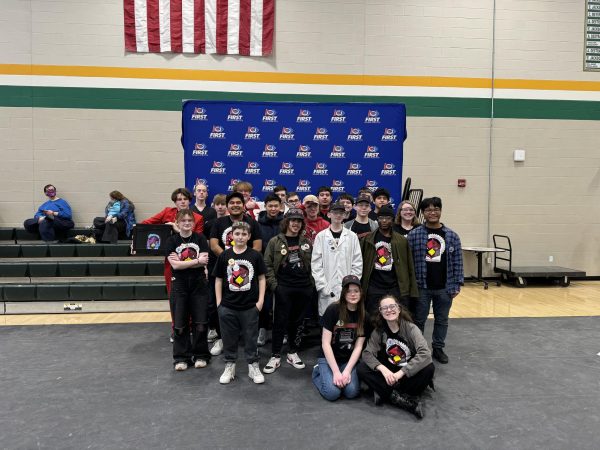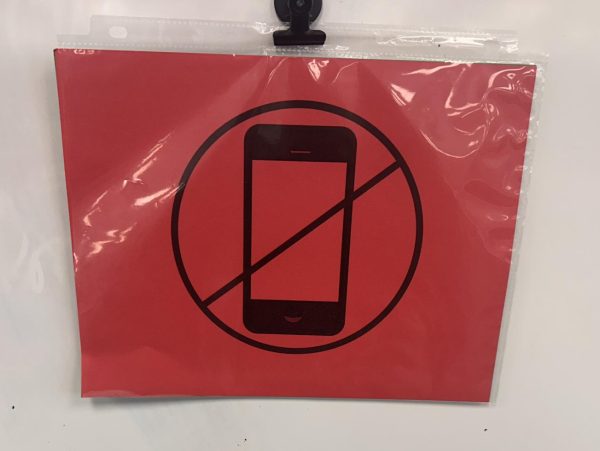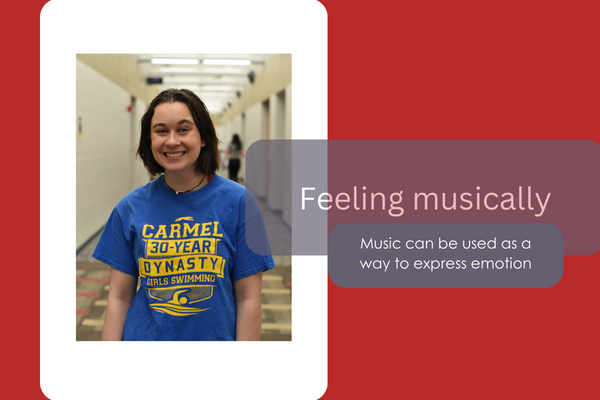Rebuilding Robotics
SHS robotics team changes structure to further enrich competitors
Juniors Katie Essex and Jurek Bergman test their robot to ensure it works. Each team inspected their robots during practice that day.
In the past, the SHS Robotics team has typically worked together to build and program one giant robot. This year, that’s changing. The team is now divided into six groups, and each group is responsible for the creation of one small robot.
Project Lead The Way teacher Mark Snodgrass has been coaching the SHS robotics team for seven years, and this year he is aiming to have every student take part in a job and learn a new skill.
“We wanted to reboot our kids because with COVID, learning became hard,” Snodgrass said. “And kids are really adapting back into the full swing of school and we didn’t want to spend $15,000 on a big robot that we couldn’t guarantee that the kids were actually doing.”
Previously, the Robotics program has been split into two teams, the middle school team and the high school team. The teams work under the FIRST (For Inspiration and Recognition of Science and Technology) robotics program, and previously, the middle school and high school worked with different challenges.
 However, Snodgrass ran into a roadblock when he realized that he couldn’t keep up with helping both groups of students learn to their full potential.
However, Snodgrass ran into a roadblock when he realized that he couldn’t keep up with helping both groups of students learn to their full potential.
“Last year I coached both again, but I couldn’t help the middle school as much as I had wanted because I had to do high school stuff at the same time,” Snodgrass said. “I had several adults who were trying to help do high school stuff, so I couldn’t tell what they were actually doing well or not.”
There were more deciding factors in making the change including losing a design engineer, a lack of experienced students, financial limits and teacher burnout. All in all, a change seemed necessary.
There are now six different groups of students, four high school teams and two middle school teams, each with six students. Students are assigned a single job in each group, giving them a chance to focus on building one skill at a time.
“We just paused big stuff and said, ‘let’s focus on learning,’” Snodgrass said. “Once we get our learning reset, we can focus on getting more mentors and then we can go back to building a big one (robot). So our goal would then be to let everybody do this until January, then we do the big one for that competition, and if we progress with the small ones too, cool. If we don’t, oh well.”
This decision is affecting both middle school and high school students. According to eighth grade student Hunter Faut, there will be many changes made to how students’ ideas will function in a smaller group setting.
“This year it’s a lot different because we’re all in different teams,” Faut said. “So we all have different ideas to cooperate together with in smaller groups, so that definitely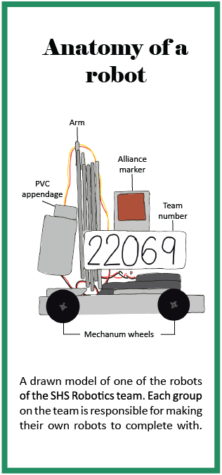 impacts the severity of each idea and how complex each idea can turn into.”
impacts the severity of each idea and how complex each idea can turn into.”
From an individual perspective, eighth grade student Will Van Camp will have more time to focus on building his own personal abilities rather than making sure other students are filling out their responsibilities.
“I have a lot less responsibility now, which is good,” Van Camp said. “Because now, I’m not making sure people aren’t messing around and breaking things. I also have more, but I have more hands-on stuff to do, like designing a hook.”
Even for experienced members like juniors Sarah Cook and Katie Essex, the change has provided them with additional learning opportunities that they didn’t have before.
Cook has been able to spend more time working personally with the robot and has increased responsibilities. She has also been able to perform more specific jobs within the team and improve on some of her weaker skills, such as making the CAD (Computer-aided design) model.
Essex was the overall robotics captain last year, but this year she is simply in charge of her own building group. She didn’t have much chance to be present in the building shop last year, but this year her role is much more hands-on.
“I’ve gotten to play a larger role in the entire thing and I really feel like it strengthened my connection not only to robots but to the team and the idea of engineering as a whole,” Essex said, “which has been really exciting.”
Snodgrass’s goals for this year are to have at least six students who are comfortable in each role, which will hopefully translate into having a team full of experienced students ready to build a larger scale robot.
“If we have that, then we have enough people and enough experience the next year to divide into our subgroups and, without losing people, build a big robot,” Snodgrass said.
We strive in the future to meet the needs of every kid who wants to do this.
— Robotics coach Mark Snodgrass
The FIRST robotics program currently has $80 million in college scholarships, and that number rises every year. Snodgrass chose this program due to the freedom it allows to build and reuse parts and the benefits it provides for students. The change made this year is an effort to keep a cherished program afloat.
“We strive in the future to meet the needs of every kid who wants to do this,” Snodgrass said.

Hi sisters, I’m Sophie Barker and this year I’ll be working as the News Editor for The Journal! I’m currently a junior and this will be my second...


